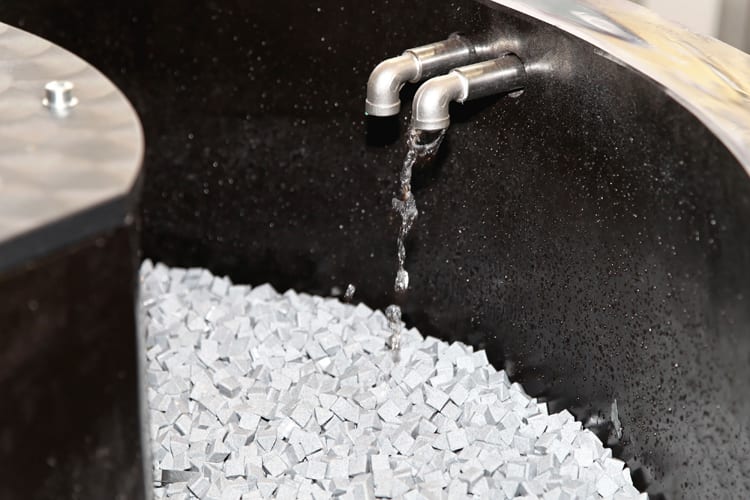As vibratory deburring may seem relatively a niche market, it ought to be noted that a massive array of mass-produced plastic, metal and even (in some instances) wooden parts require deburring.
The United Kingdom is a house of vibratory deburring. Most of these machines are also a common solution for many manufacturing groups worldwide.
Vibratory finishing is a metal finishing process. You can use it to burnish, descale, deburr and clean metal components after manufacturing. The majority of the metal finishing experts use a complete collection of vibratory finishing gear such as a tub, bowl, and some other equipment.
In this article, we are going to discuss the process of vibratory machines and how it uses plastic or tumbling media (get information about tumbling media here) to finish the parts.
The Process of Vibratory Machines
The vibratory finishing process utilizes specifically formed abrasive media to get the required finishing effect.
Firstly, the abrasive media is put into a container along with the particular parts to be finished; then, an off-center revolving weight operates within this container, inducing the tub to vibrate and shake.
The cyclical shake of the tub drops and lifts the container’s items frequently in fast succession. This will cause the abrasive media to interrelate with all the metal parts in a manner that is quite similar to standard processing exactly where a media makes contact with the particular part. The surface area is smoothed and eroded until achieving the required finish.
Vibratory finishing is actually a batch procedure, suitable for processing large multiple small workpieces. Because the vibratory action processes the entire load as a single unit, it’s perfect for finishing parts which are more vulnerable – the impacts within the parts and abrasive media are equal, reducing the potential risk of ripping and other part deformation.
Several vibratory finishers can easily be started while in use, enabling skilled workers to inspect parts during the continuous finishing process aesthetically.
The vibratory finishing process creates an array of different coatings on parts. The particular finish is usually controlled by changing the amplitude and frequency of the vibratory finishing equipment.
Standard wavelengths range from 800 to 3,800 rounds per minute (CPM); amplitude, the difference between the lowest and highest point of the particular cycle, may range from 1 to 5.78 millimetres.
Equipment Used for Vibratory Finishing Process
Many manufacturers use a complete range of vibratory equipment, such as bowl type finishers, tub type finishers, and ongoing (generally known as thru-feed), finishing process.
Bowl Finishers
Bowl finishers, as their name signifies, are in the shape of bowls. Usually, with a rising approach, bowl vibratory finishers are perfect for polishing, deburring, smoothing, and cleaning large quantities of both medium and small-sized parts.
Larger Than Bowl Finishers
Larger than bowl finishers are a tub type vibratory finisher that accommodates larger parts and larger quantities as compared to bowl finishers. Usually rectangle-shaped, several tub finishers are split into chambers, making it possible for the synchronised finishing of different parts, or different stages in the particular finishing process of any single part.
Ongoing Vibratory Finishing
The ongoing vibratory finishing process is the largest vibratory cleaner available. They’re made to properly process extremely large quantities of parts in a continuous, assembly line-type system. They are easily incorporated into ongoing materials handling systems and are equipped with rotating separators.
Vibratory Deburring Units
Vibratory deburring units rarely malfunction and the uniformed effects are easy to replicate time after time. With the most up-to-date machines coming complete with sealed bearings as well as the fabrications being exhausted and allayed, these types of machines require minimal levels of routine maintenance.
With the standard deburring of metal casting and pressings, applications can easily improve surfaces from 1.2 ra to 1.03 ra.
Regarding all the information above about process and equipment used in vibratory machines, it’s obvious to notice the reason why the automotive, sports, medical and aerospace industries have been using vibratory deburring for decades.
How Does It Work?
The vibratory deburring machines are made up of the process chamber (generally covered with a protective polyurethane or rubber) which is attached to base and springs. The particular process chamber is usually spherical with a centre vibration plate on which the motor is installed.
Circular Bowl Deburring Machines
The vibrations induce the media (polishing/abrasive chips) in the chamber to rotate in a toroidal (corkscrew) motion. This particular motion induces the media to impact the surface area of the components.
With the correct levels of water, media, process time and chemical additive, this process produces good results which range from edge deburring, breaking to burnishing, super-finishing, descaling, degreasing, radiusing and rust inhibition.
Circular bowl vibratory deburring machines were first introduced over 4 decades ago and now work for the majority of sales because the design guarantees that part damage can easily be averted and that a screen and flap can easily be controlled to isolate the part from the media/chips.
Vibratory Trough Deburring
Because of the shape, vibratory troughs have the best solution for refining larger/heavier components such as curtain poles, turbine blades poles, tube blocks etc. As large components are delicate, divider plates create chambers giving separate compartments which entirely remove the possibility of part-on-part damage.
Automated unloading isn’t generally supplied with troughs and yes it ought to be considered that components have a tendency to move to the ends of the holding chamber which may cause impingement). That’s the reason troughs are very important to avoid the part damages.




